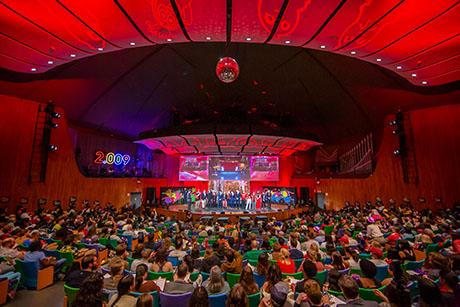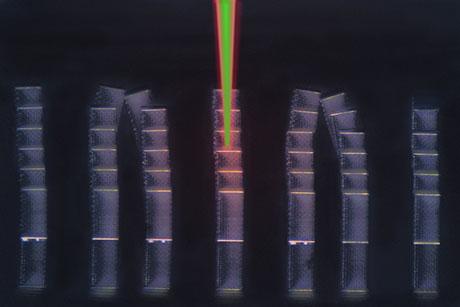An Eye for Design
Maria Yang helps product designers hone the creative process.
Are you a doodler or a scribe? Do you prefer pen and paper, or keyboard and mouse? Do you outline your thoughts, or let them flow freely?
Maria Yang, an associate professor of mechanical engineering at MIT, believes the ways in which people formulate ideas — particularly when designing new products — can significantly influence those products’ success.
“People’s strategies are so fascinating,” says Yang, who studies the creative strategies of designers in the very early stages of product development. “We observe them, and try to understand what their thought process is. Do different approaches work better than others? Because we want people to design better products and systems — that’s the bottom line.”
As founder and director of MIT’s Ideation Lab, Yang helps designers — including architects, planners, designers, and engineers — improve their creative process by measuring the activities they engage in. She’s helped designers work toward a wide range of goals: developing software interfaces, coordinating complex space systems, and establishing infrastructure for residential solar power.
In one of her recent papers, she says her research team explored the question, “If you sketch, or build prototypes, or explore using CAD [computer-aided design] models, can we measure if certain tools mean are linked with a better design result?” Yang says, “It’s not easy to change people. But if we give them better tools or processes, they can design better.”
She also teaches students how to uncover ways to improve design in the world around them. In her course 2.00 (Introduction to Design), she tells students to look for “pain points” — situations in which users have difficulty in using a product, which are usually a ripe opportunity for better design.
In one class, she recalls a student team came up with an idea for a product based on the experience of slicing a block of cheese with a chef’s knife. The pressure applied to the knife left a long indentation on the palm. As a solution, the team designed a device to distribute the force across the palm.
“That was literally a pain point!” Yang exclaims. “The world tells you what it needs — it’s just not always obvious.”
Playing with design
Yang was born and raised in West Lafayette, Indiana, where her father was a professor of aeronautics and astronautics at Purdue University. Her mother stayed home with Yang and her sister, and eventually earned a master’s degree in higher education administration, going on to teach Chinese calligraphy at the university.
Looking back on her childhood, Yang now recognizes a design theme to her interests, though she didn’t realize it at the time.
“As a kid, I liked a toy called ‘The Sunshine Family’ — a family of plastic dolls, not the glamorous kind,” Yang recalls. “The goal of the toy was to get kids to make products for dolls, so you would make an old toothpaste cap into a cup, and so forth. That’s basically the little kid version of what I do now.”
In high school, she excelled in math and science, although she also took college courses in psychology and sociology. “That was my high school way of trying to understand users, though I didn’t know it at the time,” Yang says.
When it came time for college, Yang applied and was accepted to MIT, where she remembers her undergraduate years as a mix of attitudes and ideas.
“I went from living in Senior House, which was a little counterculture, to McCormick, which was a little more traditional,” Yang says. “I experienced the full spectrum.”
She wound up majoring in mechanical engineering, and was instantly drawn to the design courses. Not surprisingly, she now teaches design courses like 2.00b (Toy Product Design) and 2.739 (Product Design and Development).
Academic pull
After graduating from MIT, Yang headed to Stanford University, where she earned a master’s and PhD from the mechanical engineering department’s design division. During graduate school, she worked at Apple, developing software for collaborative interaction design teams, and at Lockheed Martin, designing software interfaces for design collaboration.
The experience with industry prompted Yang to take a break from academia. After earning her PhD, she went to work for Reactivity, Inc., a consultancy and incubator in the Bay Area that helped startups with the design of first-generation prototypes. The experience was equal parts exhausting and exhilarating, although Yang increasingly felt the pull of academia.
“I had always had this tension of whether I wanted to do design, or study design,” Yang says. “I missed academia, and the idea of being able to research the things I wanted to.”
To ease back into academic life, Yang took a postdoctoral position at Caltech, which eventually led to a faculty position at MIT.
“At MIT there are so many different viewpoints on design, all exciting, and I thought this would be a great place for me to find the right cohort of people to work with,” Yang recalls.
The long tail
In her product design research, a typical project might see Yang invite practicing Boston-area designers to her lab, where she gives them a design task, along with several tools to work with, such as sketching, CAD models, and foam blocks. She then records each designer as they work with a tool. Afterwards, she posts the designers’ final products, and crowdsources with hundreds of people to see which products they perceive as most user-friendly or desirable.
“We found that with fast, lower-fidelity methods, like foam and sketching, people came up with more ideas — there’s a higher volume,” Yang says.
Ultimately, quantity may be the key to a good product design. When faced with a blank page or computer screen, Yang advises students to defer judgment, and instead, write down any and every idea that comes to them — plausible or not.
“If I have a room of 20 people with the same design problem, say a new kind of coffee cup for commuters, I can guarantee you that most of those 20 people will come up with many of the same first five ideas,” Yang says. “Once you get past 10, 20, 100 ideas — that’s the long tail, and those are ideas that have not been farmed before. So you just want to get your motor running.”



